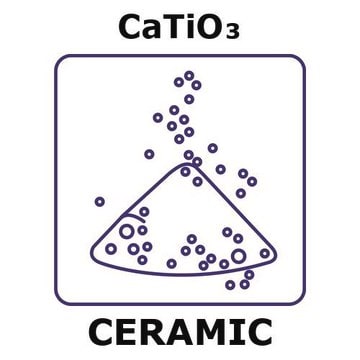The particle size for this product has been frequently reported as 1-2µm. The particle size can vary, but will be <5µm
所有图片(3)
About This Item
线性分子式:
SrTiO3
CAS号:
分子量:
183.49
EC 号:
MDL编号:
UNSPSC代码:
12352300
PubChem化学物质编号:
NACRES:
NA.23
价格与库存信息目前不能提供
推荐产品
方案
99%
表单
powder
反应适用性
reagent type: catalyst
core: titanium
mp
2060 °C (lit.)
密度
4.81 g/mL at 25 °C (lit.)
SMILES字符串
[Sr++].[O-][Ti]([O-])=O
InChI
1S/3O.Sr.Ti/q;2*-1;+2;
InChI key
VEALVRVVWBQVSL-UHFFFAOYSA-N
正在寻找类似产品? 访问 产品对比指南
储存分类代码
11 - Combustible Solids
WGK
WGK 3
闪点(°F)
Not applicable
闪点(°C)
Not applicable
个人防护装备
Eyeshields, Gloves, type N95 (US)
其他客户在看
Archana Pandey et al.
ACS nano, 7(1), 117-125 (2012-12-04)
Novel PMMA-STO-CNT matrices were created by opened-tip vertically aligned multiwalled carbon nanotubes (VA-MWCNTs) with conformal coatings of strontium titanate (STO) and poly(methyl methacrylate) (PMMA). Emission threshold of 0.8 V/μm was demonstrated, about 5-fold lower than that of the as-grown VA-MWCNTs.
Qiang Xu et al.
Ultramicroscopy, 111(7), 912-919 (2011-06-15)
The knowledge of the valence electron distribution is essential for understanding the properties of materials. However this information is difficult to obtain from HREM images because it is easily obscured by the large scattering contribution of core electrons and by
L Avilés Félix et al.
Nanotechnology, 23(49), 495715-495715 (2012-11-17)
The transport properties of ultra-thin SrTiO(3) (STO) layers grown over YBa(2)Cu(3)O(7) electrodes were studied by conductive atomic force microscopy at the nano-scale. A very good control of the barrier thickness was achieved during the deposition process. A phenomenological approach was
Troy K Townsend et al.
ACS nano, 6(8), 7420-7426 (2012-07-24)
SrTiO(3) (STO) is a large band gap (3.2 eV) semiconductor that catalyzes the overall water splitting reaction under UV light irradiation in the presence of a NiO cocatalyst. As we show here, the reactivity persists in nanoscale particles of the
Ralf Moos et al.
Sensors (Basel, Switzerland), 11(4), 3439-3465 (2011-12-14)
Resistive oxygen sensors are an inexpensive alternative to the classical potentiometric zirconia oxygen sensor, especially for use in harsh environments and at temperatures of several hundred °C or even higher. This device-oriented paper gives a historical overview on the development
-
Can please you provide information on the particle size distribution?
1 answer-
Helpful?
-
Active Filters
我们的科学家团队拥有各种研究领域经验,包括生命科学、材料科学、化学合成、色谱、分析及许多其他领域.
联系客户支持







